Abstract
In this study, through simple ammonia impregnation, more amine functional groups could be introduced into the zeolite 4A synthesized using fly ash, which efficiently improved the mercury ion removal capacity of modified zeolites. The impregnation-modification mechanism of NH3·H2O, ammonium chloride, and silane coupling agent (KH792) for zeolite 4A, and the Hg2+ ion removal-efficiency by aminated zeolites, were studied and compared. Through ion exchange and hydroxyl reactions, NH3·H2O impregnation introduced the same kinds of nitrogen-containing groups into zeolite as KH792 grafting, which was more than the NH4Cl modification. The Hg2+ ion adsorption capacity of NH3·H2O-zeolite was higher than those of KH792-zeolite and NH4Cl-zeolite through ion exchange and the complexation of nitrogen-containing groups. When coexisting with Pb2+, Cu2+, and Zn2+ ions, the Hg2+ ion removal rate of NH3·H2O-zeolite was still higher than 99%. After five adsorption and desorption cycles, the Hg2+ ion removal rate of NH3·H2O-zeolite was 72.03%. When NH3·H2O-zeolite was added to the leaching of mercury-contaminated soil, the content of soluble mercury significantly decreased. Therefore, we synthesized a potential cheap and safe adsorbent using fly ash as the main raw material through the simple NH3·H2O impregnation modification for the treatment of mercury-contaminated water and soil.
1. Introduction
Mercury (Hg) has strong toxicity. After entering the human body, even a small amount of Hg will lead to multiple human diseases and neurological and renal dysfunction [1]. Therefore, mercury-contaminated water and soil may have adverse effects on human health. Among mercury-removal methods, the adsorption method is commonly used because of its low cost, fast treatment speed, simple operation, and renewable advantages [2,3]. Zeolite is a conventional adsorbent that can remove heavy metal ions from a solution through ion exchange. It is often used to remove Hg2+ ions in water [4].
Due to the fact that the main elements of zeolite are silicon and aluminum, industrial waste fly ash with silicon and aluminum as the main components is often used to synthesize zeolite to reduce the material cost and realize waste utilization [5,6]. However, the removal ability of zeolite for Hg2+ ions needs to be improved, so it is often modified to increase its adsorption capacity [7]. Due to the fact that amino groups can chelate with Hg2+ ions through the free-electron bimodal characteristics of nitrogen and have a strong adsorption ability for Hg2+ ions in solution [8], zeolites are often aminated to improve their mercury-removal capacities [9].
There are two main methods for the amination modification of a zeolite: one is high-temperature activation, the other is impregnation. High-temperature activation modification is to introduce an amino group from ammonia to the zeolite structure. NH3 can only be decomposed with the removal of a H atom to form an amino group after being heated to above 600 °C, which is then connected with Si on the zeolite surface [10,11]. Therefore, NH3 modification has a high energy consumption; in addition, the nitrogen content introduced into microporous zeolites is low, generally 1 wt%–2 wt% [12]. Impregnation modification involves impregnating the zeolite into inorganic ammonium salt or an organic nitrogen-containing substance solution, then introducing an ammonium ion or amine functional group in the zeolite channel and surface through ion exchange, loading, and grafting [13,14]. The impregnation is a commonly used method for the zeolite amination modification because of its simple operation and low energy consumption [15].
When inorganic ammonium salt is used to modify the zeolite by impregnation, ammonium ions can enter the zeolite channel by exchange with cations in zeolite [16], but due to the influence of the cation site of the zeolite, they can only exchange with cations in the quaternary ring and hexagonal ring on the zeolite surface [17], and the nitrogen content introduced is low. When organic nitrogen-containing substances are used to impregnate zeolites, the nitrogen-containing functional groups are easily grafted onto the zeolite surface [18]. Due to the fact that organic substances can contain more nitrogen-containing functional groups, more amino groups can be introduced in the zeolite; thus, zeolites modified by organic amines have a high adsorption efficiency for pollutants [19]. However, when a zeolite modified by organic amines is used to treat mercury-contaminated water and soil, due to the weak interaction between the introduced organic nitrogen-containing groups and the zeolite, the organic amines may leach into the environment and bring risks [20]. Thus, although organic impregnation modification can introduce many nitrogen-containing groups into a zeolite, the organic products may bring environmental risks, while the previous inorganic impregnation modification will not bring environment risks, but the ammonium content introduced into the zeolite is limited, and the adsorption capacity of modified zeolites for Hg2+ ions cannot be effectively improved. Therefore, it is necessary to study how to improve the content of nitrogen-containing groups introduced into zeolite by using the inorganic impregnation method.
In this study, a simple inorganic-ammonia-impregnation method was used to modify zeolite 4A synthesized using fly ash. The modification mechanism, the contents of the introduced amino groups, and the Hg2+ ions’ removal efficiency were analyzed and compared with organic grafting modification and inorganic ammonium chloride modification. On this basis, the Hg2+ ion adsorption mechanism, the removal efficiency of multiple coexisting ions, and the reusability of the modified zeolite were further determined. Finally, the modified zeolite was added to the leaching solution of the mercury-contaminated soil and the Hg2+ ion content was analyzed.
This study attempts to supply an inorganic amination modification method of a zeolite with a low-energy operation and efficient removal of Hg2+ ions using fly ash as a raw material to synthesize a potential cheap and safe adsorbent for the treatment of mercury-contaminated water and soil.
2. Materials and Methods
2.1. Materials and Reagents
The raw materials used in the synthesis of zeolite 4A were fly ash (43.98% Al2O3, 43.89% SiO2) obtained from Ordos (Inner Mongolia, China) and diatomite (2.49% Al2O3, 89.16% SiO2) purchased from Fengsheng Mining of China as a supplementary Si source. The reagents used in this study included sodium hydroxide (NaOH, 96%, assay), ammonia monohydrate (NH3·H2O, 25%, assay), silane coupling agent (KH792, 99%, assay), hydrochloric acid (HCl, 38%, assay), sodium carbonate (Na2CO3, 99.80%, assay), ammonium chloride (NH4Cl, 99%, assay), and potassium iodide (KI, 99%, assay). The Hg-contaminated solution was prepared using mercury chloride (HgCl2, 99.50%, assay), and ZnSO4·7H2O (99.00%, assay), Pb(NO3)2 (99.00%, assay), and Cu(NO3)2·3H2O (99.50%, assay) were used to prepare multiple ion coexistence solutions.
2.2. Instruments
An X-ray diffractometer (XRD, Ultima IV, Rigaku Corporation, Tokyo, Japan) was used to analyze the diffraction patterns of the modified zeolite and the zeolite before and after the adsorption of the Hg2+ ions. A scanning electron microscope (SEM, SU8010, Hitachi Ltd., Tokyo, Japan) was used to observe the surface morphology of the zeolite. A surface area and porosity analyzer (ASAP 2460, Micromeritics Instrument Corporation, Norcross, GA, USA) was used to measure the BET surface area and N2 adsorption–desorption isotherm of the adsorbents before and after modification. The contents of the organic materials before and after zeolite grafting were measured by an organic-element analyzer EA (UNICUBE, Elemental Analysis Systems Co., Ltd., Hanau, Germany). The functional groups before and after modification and the adsorption of the zeolite were measured by Fourier transform infrared spectroscopy (FTIR, Perkin Elmer Frontier, Perkin-Elmer Ltd., Waltham, MA, USA). An inductively coupled plasma optical emission spectrometer (ICP-OES, ICPE-9800, Shimadzu Company, Kyoto, Japan) was used to measure the Na+ ion concentration before and after zeolite modification. The Hg2+ ion concentration in the solution was measured by flame atomic absorption spectrometry with a hydride generator (FAAS-HVG-100, Shimadzu Company, Kyoto, Japan).
2.3. Synthesis and Amination Modification of Zeolite 4A
2.3.1. Zeolite 4A Synthesis
The zeolite 4A used in the experiment was hydrothermally synthesized with fly ash as the raw material. The specific synthesis steps were described in our previous study [21]. Fly ash, diatomite supplemented with a silicon source, and the alkali activator NaOH were mixed in a proportion of 9.1:0.9:16, and zeolite 4A was obtained after alkali melting, stirring, aging, crystallization, washing, and drying.
2.3.2. Inorganic Amination Modification
First, zeolite 4A, synthesized using fly ash, was dried, ground and passed through 200 mesh sieves, and then 3 g was added into NH3·H2O with different concentrations for 48 h. Through batch experiments, we determined that the best concentration of NH3·H2O was 10 wt%. After impregnation, the zeolite was vacuum filtered, washed, dried at 50 °C for 12 h, and then sealed and stored. The zeolite modified by NH3·H2O impregnation was named NH3·H2O-zeolite 4A.
The NH4Cl modification mainly refers to Ikeda et al.’s method [22], but was further improved. The preparation steps were as follows: 3 g of zeolite 4A was slowly added into 0.5 M NH4Cl, and then the mixture was stirred at 80 °C for 4 h, washed with deionized water, and filtered. Finally, the mixture was dried at 50 °C overnight and a modified zeolite was obtained, named NH4Cl-zeolite 4A.
2.3.3. Organic Graft Modification
The organic graft modification mainly refers to the method put forth by Han et al. [23]. First, 50 mL of 95 wt% ethanol solution was added to a flask and stirred at 25 °C for 5 min. Then, 5 g of zeolite was put into the ethanol solution and continuously stirred. Then, 50 mL of 90 wt% ethanol was added to another flask and stirred at 25 °C for 5 min, and 5 wt% silane coupling agent (KH792) was slowly dropped with a disposable syringe and then stirred with ultrasonication for 0.5 h to ensure reagent hydrolysis. The obtained hydrolysis solution was quickly added to the mixture of the zeolite and ethanol and stirred and reacted at 60 °C for 4 h. Then, the obtained product was washed repeatedly with absolute ethanol and filtered in vacuum to remove the unreacted KH792. The filtered product was dried in a vacuum oven at 80 °C for 2 h and then ground and passed through a 200 mesh sieve to obtain the modified zeolite named KH792-zeolite 4A.
2.4. Adsorption Experiment
HgCl2 (0.1354 g) was dissolved in 100 mL of deionized water to obtain a 1 g/L standard solution. Then, the standard solution was diluted, and Hg2+ ion solutions with different concentrations were prepared. The pH of the solution was adjusted with 0.1 M HCl and 0.1 M NaOH. Without special instruction, the initial concentration of Hg2+ ions was 10 mg/L, the amount of adsorbent was 0.1 g, the adsorption temperature was 25 °C, and the adsorption time was 240 min.
To determine the adsorption efficiency and the mechanism of the adsorbent for Hg2+ ions, batch experiments were carried out on the dosage of adsorbent, pH of the initial solution, concentration of the initial solution, adsorption time, and adsorption temperature. According to our previous research [24], when the solution’s pH was lower than 2, the zeolite structure could be destroyed under strong acid conditions. Moreover, due to the existence of Cl− ions in the solution, when the solution pH was low, the Cl− and Hg2+ ions could form anionic complexes, such as HgCl3− [25,26,27], while when the pH was high, the Hg2+ ions would form negatively charged metal complexes with OH− ions in alkaline conditions [28]. Thus, the pH range of the Hg2+ initial solution in this study was set from 3 to 7. The Hg2+ ion concentration gradients of isothermal adsorption were set to 5, 10, 20, 30, 50, 80, 100, 200, 300, 400, 450, and 500 mg∙L−1. The time gradients of adsorption kinetics were 2, 7, 12, 30, 60, 120, 180, and 240 min, respectively. The thermodynamic temperature gradients were set at 25 °C, 35 °C, and 45 °C. All experiments were carried out in an oscillator at 180 rpm. After adsorption, the solution was filtered using a disposable syringe with a 0.45 μm filter membrane. Each adsorption experiment was repeated twice. The adsorption rate Qc (%) and adsorption capacity Qe (mg/g) of the adsorbent for the Hg2+ ions were calculated by the following equations:
where C0 and Ce are the Hg2+ ion concentrations in the initial and adsorption equilibrium solutions, respectively, mg/L; V is the volume of solution, L; and m is the adsorbent amount, g.
2.5. Cation Effect on Hg2+ Ion Adsorption
The Hg2+ ion adsorption rate of NH3·H2O-zeolite 4A with the coexistence of Pb2+, Cu2+, and Zn2+ ions at the same concentration in the solution was studied. The initial ion concentration was 10 mg/L, the pH was 6, and 0.1 g of NH3·H2O-zeolite 4A was added. After shaking for 4 h at 25 °C to reach adsorption equilibrium, the concentration of each cation was measured. The experiments were repeated twice, and the average value was taken as the final measured value.
2.6. Zeolite Reuse Experiment
A KI solution was used as the adsorbent eluent. After adsorption saturation with 1 g/L Hg2+ ions, 0.5 g of NH3·H2O-zeolite 4A was put into 50 mL of the 0.1 M KI solution, and the solution was shaken at 25 °C for 60 min with a frequency of 180 rpm for desorption. Then, the sample was filtered and washed with deionized water, and this process was repeated three times to fully desorb the adsorbed Hg2+ ions. Finally, the washed sample was dried for the next adsorption experiment. Five adsorption–desorption experiments were conducted. Each group of experiments was repeated twice.
2.7. Removal of Hg2+ Ions in Soil Leaching by the Modified Zeolite
According to our previous study, the soil around the Tangshan steel plant was seriously contaminated by mercury [29]. A 1 g soil sample with the highest mercury content around the steel plant was added to 20 mL of deionized water, and then 0.01 g of NH3·H2O-zeolite 4A was added. At the same time, a blank control experiment was set. The samples were shaken for 6, 18, 24, 36, and 48 h to measure the Hg2+ ion concentration in the soil-leaching solutions. Each experiment was repeated twice.
3. Results
3.1. Amination Modification of Zeolite
3.1.1. Characterization
Zeolite 4A was successfully synthesized using fly ash. The XRD pattern showed that the characteristic peaks of the synthesized zeolite 4A were 7.2°, 10.3°, 12.6°, 16.2°, 21.8°, 24.0°, 27.2°, 29.9°, and 34.2° (Figure 1a), which were consistent with the standard peaks of zeolite 4A [30]. The characteristic peaks of NH3·H2O-zeolite 4A, KH792-zeolite 4A, and NH4Cl-zeolite were the same as zeolite 4A, indicating that the three modifications did not affect the skeleton structure of zeolite (Figure 1b–d).

Figure 1.
XRD patterns of zeolite 4A (a), NH3·H2O-zeolite 4A (b), KH792-zeolite 4A (c), and NH4Cl-zeolite 4A (d).
Zeolite 4A synthesized using fly ash was a typical small cube (Figure 2a). The surface morphologies of NH3·H2O-zeolite 4A and NH4Cl-zeolite 4A showed no significant changes compared with the original zeolite (Figure 2b,c). However, compared with the original zeolite, the surface of KH792-zeolite 4A became rough (Figure 2d), which may have been because the silane group of KH792 reacted with the free hydroxyl group on the zeolite surface to form a covalent bond and reduce the surface tension of the modified zeolite, and the adhesion between the grafted amine functional groups of KH792 increased the trend of large agglomerate formation [31].
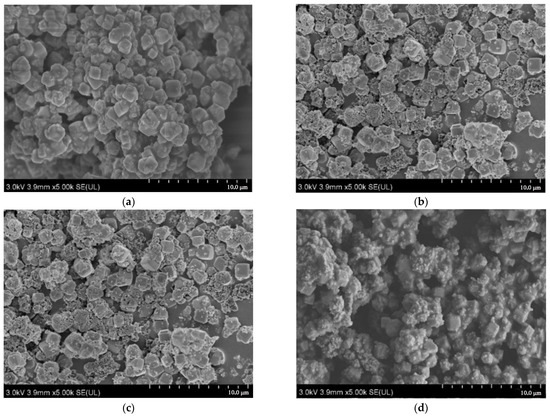
Figure 2.
Morphological characteristics of zeolite 4A (a), NH3·H2O-zeolite 4A (b), NH4Cl-zeolite 4A (c), and KH792-zeolite 4A (d).
3.1.2. Synthesis Mechanism
In the FTIR spectrum, the peak at 465 cm−1 of zeolite 4A corresponded to the bending–stretching vibration of T-O (where T is Al or Si), the peak at 558 cm−1 was the characteristic peak of the double-ring vibration in the tetrahedron, the peak at 993 cm−1 corresponded to the characteristic peak of the tetragonal stretching vibration of TOT (where T is Al or Si), and 3430 cm−1 was related to the stretching vibration of Si-OH. These characteristic peaks were the characteristic peaks of typical zeolite 4A [32] (Figure 3a). The peak at 1401 cm−1 of NH3·H2O-zeolite 4A was assigned to the deformation vibration of the NH4+ ions [33], indicating that the partial Na+ ions of zeolite 4A might have exchanged with NH4+ in the solution. The peak intensity at 993 cm−1 decreased, indicating that ion exchange might have had an impact on the ring structure. The peak at 3421 cm−1 was attributed to the Si-NH2 vibration [34], indicating that amino functional groups were formed on NH3·H2O-zeolite 4A (Figure 3b). In the FTIR spectrum of KH792-zeolite 4A, the characteristic peak at 1635 cm−1 was attributed to -N-H bonds [35], and the peaks at 2850 and 2920 cm−1 were attributed to -CH- asymmetric and symmetric stretching vibrations [36], indicating that KH792 was successfully grafted onto the zeolite. The peak at 3430 cm−1 of KH792-zeolite 4A was significantly lower than that of zeolite 4A, indicating that KH792 consumed some silanol groups on the surface of the zeolite after grafting (Figure 3c). The peak of NH4Cl-zeolite 4A at 1401 cm−1 was assigned to the deformation vibration of NH4+ [33], and the obvious peak height indicated that more NH4+ ions had exchanged with Na+ ions (Figure 3d). However, no vibration peak of Si-NH2 was found in the FTIR spectrum of NH4Cl-zeolite 4A.
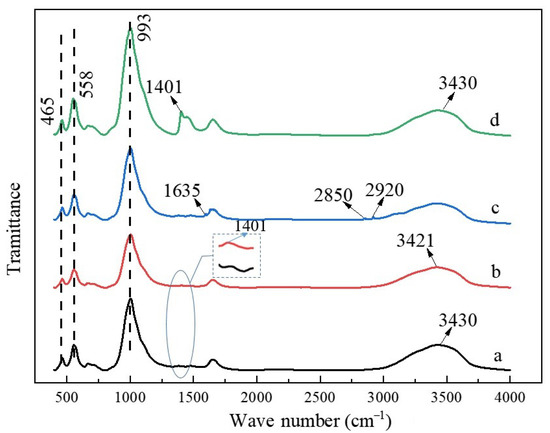
Figure 3.
FTIR spectra of zeolite 4A (a), NH3·H2O-zeolite 4A (b), KH792-zeolite 4A (c), and NH4Cl-zeolite 4A (d).
Through experimental detection, it was found that the concentration of Na+ ions in the solution after impregnating zeolite 4A with NH3·H2O was higher than that with deionized-water impregnation (Figure 4a), which shows that Na+ ions in the zeolite exchanged with NH4+ ions in NH3·H2O, and the cation exchange capacity reached 41.28%. Both this and the FTIR results prove that NH4+ ions successfully entered the structure of zeolite 4A after ammonia impregnation. The determination results of the element analyzer show that the amount of N and C in KH792-zeolite 4A increased compared with that of zeolite 4A (Figure 4b). Thus, the experimental detection and FTIR results prove that amine groups were successfully grafted onto zeolite 4A.
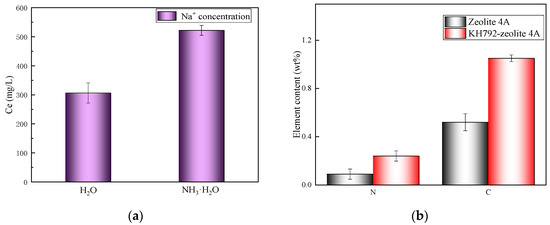
Figure 4.
Na+ ion concentration in H2O and NH3·H2O (a) and the contents of N and C elements in zeolite 4A and KH792-zeolite 4A (b).
According to the above analysis, the inorganic and organic modification mechanisms of zeolite could be determined. In the NH3·H2O and NH4Cl modifications, the Na+ ions in zeolite 4A could exchange with the NH4+ ions in the solution to form nitrogen-containing groups and enter the zeolite structure (Equation (3)). In addition, a large number of hydroxyl groups on the surface of zeolite 4A could react with NH3·H2O and introduce -NH2 groups into the zeolite [37] (Figure 3b, Equation (4)). Therefore, NH3·H2O modification could introduce more nitrogen-containing groups than NH4Cl modification, which might improve the Hg2+ ion-removal efficiency of the modified zeolite in the solution.
During organic modification, the silicon atom in KH792 could react with the hydroxyl group on the zeolite surface [38] and introduce amino functional groups onto zeolite 4A (Figure 5). Due to the fact that KH792 contains two amino functional groups, the amount of amino functional groups introduced by the organic grafting modification was the same as those introduced by inorganic NH3·H2O impregnation.

Figure 5.
Chemical-grafting process between KH792 and zeolite 4A.
3.1.3. Pore Size Distribution
Through the N2 adsorption–desorption isotherms (Figure 6), the specific surface areas of zeolite 4A, NH3·H2O-zeolite 4A, and KH792-zeolite 4A were 20.9 m2/g, 28.4 m2/g, and 31.33 m2/g, respectively, indicating that the specific surface areas of the modified zeolites were improved. The isotherms of all of the adsorbents were type I [39], which belonged to a typical microporous structure, indicating that aminated modification could not change the microporous structure of zeolite 4A.

Figure 6.
N2 adsorption–desorption isotherms of zeolite 4A (a), NH3·H2O-zeolite 4A (b), and KH792-zeolite 4A (c).
3.2. Hg2+ Ion Adsorption by Modified Zeolite
3.2.1. Adsorption Efficiency
The Hg2+ ion-adsorption rate of zeolite 4A was only 75.5%, while the Hg2+ ion-adsorption rates of NH3·H2O-zeolite 4A and KH792-zeolite 4A were 99.25% and 98.31%, respectively, indicating that the Hg2+ ion-removal abilities of these two kinds of modified zeolites were significantly improved (p < 0.05) (Figure 7). The Hg2+ ion-adsorption rate of NH4Cl-zeolite 4A was 85.05%, which was significantly improved compared with that of the original zeolite 4A, but was significantly lower than those of the other two modified zeolites (p < 0.05), which might be due to the small amount of nitrogen-containing groups introduced into NH4Cl-zeolite 4A. Thus, the adsorptions of Hg2+ ions by NH3·H2O-zeolite 4A and KH792-zeolite 4A were mainly studied and compared.
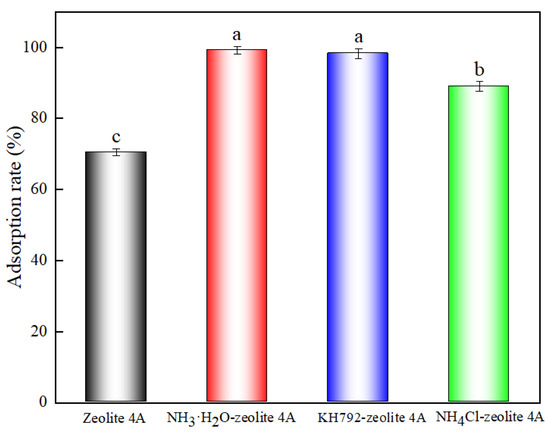
Figure 7.
Hg2+ ion-adsorption rates of zeolite 4A and amination-modified zeolites (adsorbent dosage of 0.1 g, pH 6, temperature 25 °C, and Hg2+ ion concentration of 10 mg/L). (The same letter on the column shows no significant difference, while different letters indicate a significant difference p < 0.05).
3.2.2. Effect of Initial Solution pH
The Hg2+ ion removal rates of NH3·H2O-zeolite 4A and KH792-zeolite 4A gradually increased with an increasing initial solution pH (Figure 8). When the initial solution pH was three, the Hg2+ ion removal rates of NH3·H2O-zeolite 4A and KH792-zeolite 4A were 85.83% and 81.51%, respectively. When the initial solution pH was six, the Hg2+ ion removal rates of NH3·H2O-zeolite 4A and KH792-zeolite 4A were the highest, reaching 99.25% and 98.31%, respectively. Due to the fact that the amino functional groups might have been protonated to form -NH3+ when the pH value was low [40], which would have reduced the adsorption ability of the modified zeolite for Hg2+ ions, the initial solution pH was set to six.
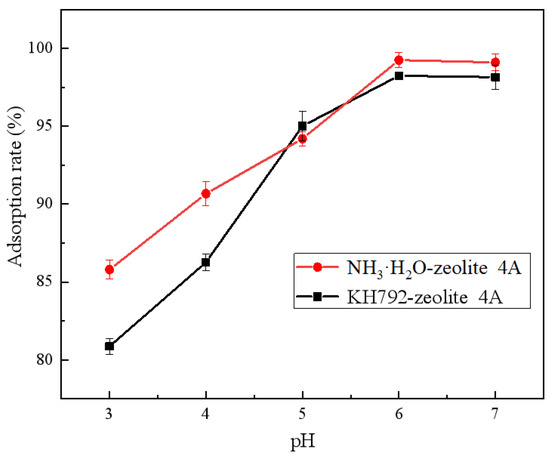
Figure 8.
Effect of initial solution pH on the Hg2+ ion-adsorption efficiency of modified zeolites (adsorbent dosage of 0.1 g, temperature 25 °C, and Hg2+ ions concentration of 10 mg/L).
3.2.3. Adsorption Model
With an increase in Hg2+ concentration, the adsorption capacity of the modified zeolite gradually reached saturation, and the maximum Hg2+ ion-adsorption capacities of NH3·H2O-zeolite 4A and KH792-zeolite 4A were 49.45 mg/g and 40.64 mg/g, respectively (Figure 9a). Through isotherm adsorption model fitting (Figure 9b,c and Table 1), the Langmuir model had the highest correlation coefficient for the modified zeolite, indicating that the removal of Hg2+ ions by NH3·H2O-zeolite 4A and KH792-zeolite 4A was the single-layer surface adsorption and irreversible [41]. According to the isothermal adsorption model fitting, the maximum Hg2+ ion-adsorption capacities of NH3·H2O-zeolite 4A and KH792-zeolite 4A were 53.55 mg/g and 42.93 mg/g, respectively, which were basically consistent with the experimental data. Therefore, the maximum Hg2+ ion-adsorption capacity of NH3·H2O-zeolite 4A was slightly higher than that of KH792-zeolite 4A.

Figure 9.
Effect of Hg2+ ion concentration on the adsorption capacities of modified zeolites (a) and the isothermal Hg2+ ion-adsorption model fitting of NH3·H2O-zeolite 4A (b) and KH792-zeolite 4A (c).

Table 1.
Isothermal adsorption parameters for the adsorption of Hg2+ ions by modified zeolites.
Through adsorption kinetic model fitting, it was found that NH3·H2O-zeolite 4A and KH792-zeolite 4A showed similar adsorption kinetic characteristics, and the Hg2+ ion desorption kinetics models of NH3·H2O-zeolite 4A and KH792-zeolite 4A were better fits with the pseudo second-order adsorption model (Figure 10 and Table 2), indicating that chemisorption was the reaction-rate control step and chemisorption was the main reaction mechanism of Hg2+ ion-removal by the two kinds of modified zeolite [42]. The kinetic parameter K2 of NH3·H2O-zeolite 4A was significantly greater than that of KH792-zeolite 4A, indicating that NH3·H2O-zeolite 4A adsorbed Hg2+ ions in solution faster than KH792-zeolite 4A, which might be due to the large molecular polymer of KH792 grafted on the zeolite surface filling or blocking the micropores of the zeolite [43] and affecting the diffusion of Hg2+ ions.
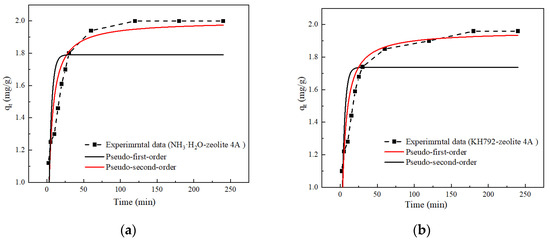
Figure 10.
The Hg2+ ion-adsorption kinetic model fitting of NH3·H2O-zeolite 4A (a) and KH792-zeolite 4A (b).

Table 2.
The adsorption kinetic model fitting parameters.
The adsorption abilities of NH3·H2O-zeolite 4A and KH792-zeolite 4A for Hg2+ ions in the solution increased with increasing temperatures (Figure 11). From the thermodynamic parameter calculation (Table 3), the ΔH° of NH3·H2O-zeolite 4A and KH792-zeolite 4A were less than 0, indicating that the adsorption processes of NH3·H2O-zeolite 4A and KH792-zeolite 4A for Hg2+ ions was exothermic; the ΔS° was greater than 0, showing that the Hg2+ ion adsorptions by NH3·H2O-zeolite 4A and KH792-zeolite 4A were entropy-increasing processes, which might be because the generated chemical bonds increased the chaos of the system [44]; and the ΔG° of NH3·H2O-zeolite 4A and KH792-zeolite 4A were less than 0, indicating that the adsorptions of Hg2+ ions by these kinds of modified zeolites were spontaneous without energy supply until the zeolites reached adsorption saturation. Usually, when the ΔH° value was in the range of 80–200 kJ/mol, the adsorption method was mainly chemical adsorption [45]. Therefore, the Hg2+ ion-removals by NH3·H2O-zeolite 4A and KH792-zeolite 4A were mainly conducted through chemical adsorption.
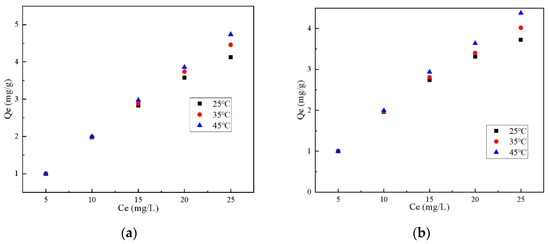
Figure 11.
Langmuir isothermal adsorption models of NH3·H2O-zeolite 4A (a) and KH792-zeolite 4A (b) at different temperatures.

Table 3.
Thermodynamic parameters of Hg2+ ion-adsorption by NH3·H2O-zeolite 4A and KH792-zeolite 4A.
Therefore, because the content of nitrogen-containing groups introduced by simple NH3·H2O impregnation was the same as that introduced by the grafting method, NH3·H2O-zeolite 4A could effectively remove Hg2+ ions in the solution by chemical adsorption. Its Hg2+ ion adsorption rate was faster than that of KH792-zeolite 4A due to the fact that the micropores of the zeolite were not blocked, unlike in organic grafting.
3.2.4. Adsorption Mechanism
The XRD pattern shows that the peak value had no obvious change before and after Hg2+ ion adsorption by NH3·H2O-zeolite 4A (Figure 12a), indicating that no crystal phase formed. However, the diffraction intensity of the characteristic peak after adsorption was significantly lower than that before adsorption, indicating that the crystallinity of the zeolite after adsorption was reduced and that the amorphous phase might have been increased [46]. According to the FTIR spectrum (Figure 12(b1)), the peak at 1401 cm−1 of NH3·H2O-zeolite 4A before adsorption was the NH4+ characteristic peak, and this peak was not found after adsorption (Figure 12(b2)), indicating that the ion-exchange reaction between NH4+ ions and Hg2+ ions had taken place. In addition, the peak at 1640 cm−1 was characteristic of the Si-OH group peak and at 3421 cm−1 was characteristic of the Si-NH2 group peak in NH3·H2O-zeolite 4A. After the adsorption of the Hg2+ ions, the peak value was obviously lower than that before adsorption, indicating that these groups complexed with Hg2+ ions (Figure 12c).
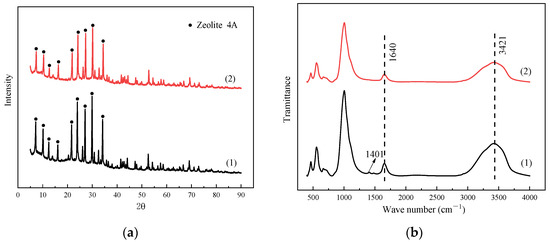

Figure 12.
XRD patterns before (1) and after (2) the adsorption of Hg2+ ions by NH3·H2O-zeolite 4A (a); FTIR spectra before (1) and after (2) the adsorption of Hg2+ ions by NH3·H2O-zeolite 4A (b); and the reaction mechanism of Hg2+ ion adsorption by NH3·H2O-zeolite 4A (c).
Therefore, through the thermodynamic analysis, the Hg2+ ion removal by NH3·H2O-zeolite was demonstrated to have mainly taken place through chemical adsorption, and the FTIR analysis shows that the main Hg2+ ions-removal mechanism was ion exchange with NH4+ introduced and a complexation reaction with the NH2 group introduced. Thus, the zeolite 4A modified by simple NH3·H2O impregnation has a higher adsorption capacity for Hg2+ ions than that of other products (Table 4) due to the introduction of more inorganic nitrogen-containing functional groups.

Table 4.
Comparison of Hg2+ ion-adsorption capacities of various adsorbents.
3.3. Coexisting Multiple Ion Effect and Reusability
When Hg2+ was mixed with Cu2+, Pb2+, and Zn2+ ions, the Hg2+ removal rate of NH3·H2O-zeolite 4A in the solution was basically unchanged, and remained at 99.325%. When Hg2+ coexisted with Cu2+, Pb2+, and Zn2+ ions, the removal rate of NH3·H2O-zeolite 4A for Hg2+ ions remained 99.325%, for Cu2+ ions was 26.05%, for Zn2+ ions was 5.95%, and for Pb2+ ions reached 99.05% (Figure 13). Thus, NH3·H2O-zeolite 4A had a high adsorption capacity for Hg2+ and Pb2+ ions, while exhibiting weak removal rates for Cu2+ and Zn2+ ions, which could be explained by RG Pearson’s soft-and-hard acid-base theory. Hg2+ and Pb2+ ions are soft acids, and the amino groups of soft bases in the modified zeolite have the ability of preferential adsorption [51]. Although the Cu2+ ion is also a soft acid, the Pb2+ ion has more orbital overlap with the lone pair electrons of nitrogen atoms, and the adsorption energy of the Pb2+ ion is less than that of the Cu2+ ion, so the Pb2+ ion would be adsorbed preferentially, and the Cu2+ ion has difficulty occupying the Pb2+ ion-adsorption site [52]. Therefore, when there were a variety of heavy metal ions in the solution, NH3·H2O-zeolite 4A maintained a high adsorption ability for Hg2+ ions.
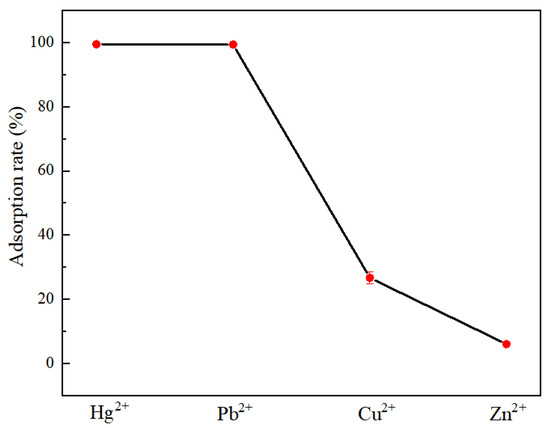
Figure 13.
Adsorption rate of NH3·H2O-zeolite 4A for Hg2+, Cu2+, Pb2+, and Zn2+ ions when these ions coexist (adsorbent dosage of 0.1 g, pH 6, temperature of 25 °C, and coexisting ion concentration of 10 mg/L).
The reusability of the adsorbent is very important to save costs in practical applications. The results of the recycling experiment show that the Hg2+ ion-adsorption efficiency of NH3·H2O-zeolite 4A was 87.22% after four cycles and 72.03% after five cycles (Figure 14a), which indicates that NH3·H2O-zeolite 4A had good reusability. FTIR spectra showed that the surface functional groups of NH3·H2O-zeolite 4A had almost no change (Figure 14b), which indicates that the nitrogen-containing functional groups introduced into the zeolite after NH3·H2O impregnation would not be affected by multiple elution. The gradual decline of the removal rate might be due to the loss of adsorbents during elution.
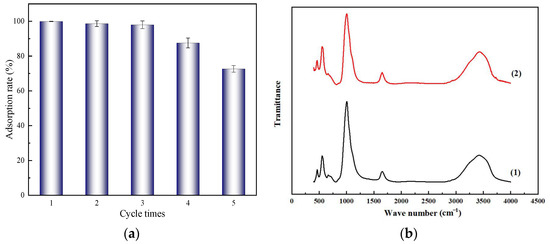
Figure 14.
The reusability of NH3·H2O-zeolite 4A for the adsorption of Hg2+ ions (a) and FTIR spectra before (1) and after 5 cycles (2) of adsorption of Hg2+ ions by NH3·H2O-zeolite 4A (b).
3.4. Hg2+ Ion Adsorption in Soil Leaching
After adding deionized water to mercury-contaminated soil, the concentration of Hg2+ ions in the leaching solution reached equilibrium after 24 h (Table 5). The maximum content of Hg2+ ions in the soil leaching was 5.82 mg/kg, while the content of Hg2+ ions in the soil leaching was only 0.17 mg/kg after adding 1% (0.01 g) NH3·H2O-zeolite 4A. Therefore, in mercury-contaminated soil leaching, NH3·H2O-zeolite 4A could efficiently remove Hg2+ ions and reduce additional soil-pollution risks.

Table 5.
Concentration of Hg2+ ions (mg/kg) in the soil leaching at different times.
4. Conclusions
In this study, zeolite 4A synthesized using fly ash was modified by simple inorganic ammonia impregnation, which could introduce more kinds of inorganic amine functional groups into the zeolite, thus improving the removal capacity of the modified zeolite for Hg2+ ions. The mechanism of impregnation modifications with NH3·H2O, KH792, and NH4Cl for zeolite 4A, and the removal capacity of Hg2+ ions by modified zeolites, were studied and compared. It was found that NH3·H2O modification could introduce nitrogen-containing groups through ion exchange and a reaction with hydroxyl groups on the zeolite surface, while NH4Cl modification could introduce NH4+ into the zeolite through ion exchange, and organic modification could introduce KH792 containing two kinds of nitrogen-containing groups into the zeolite through grafting. Therefore, NH3·H2O modification and organic grafting introduced more nitrogen-containing groups than NH4Cl modification.
The Hg2+ ion-removal rates of NH3·H2O-zeolite 4A were significantly higher than those of KH792-zeolite 4A and NH4Cl-zeolite 4A. According to the isothermal adsorption model fitting, the maximum Hg2+ ion-adsorption capacity of NH3·H2O-zeolite 4A achieved was 53.55 mg/g. The thermodynamic analysis showed that the Hg2+ ion adsorption of NH3·H2O-zeolite 4A in the solution was mainly achieved through chemical adsorption. The XRD and FTIR analyses showed that the adsorption of Hg2+ ions by NH3·H2O-zeolite 4A was mainly achieved through ion exchange between NH4+ and Hg2+ ions and the complexation of nitrogen-containing functional groups of the modified zeolite with Hg2+ ions.
When Cu2+, Pb2+, Zn2+, and Hg2+ ions coexisted, the Hg2+ ion adsorption ability of NH3·H2O-zeolite 4A was not affected. After five adsorption and desorption cycles, the Hg2+ ion-adsorption rate of NH3·H2O-zeolite 4A was 72.03%. Therefore, NH3·H2O-zeolite 4A had good reusability. When NH3·H2O-zeolite 4A was added to the leaching of mercury-contaminated soil, the content of soluble mercury in the leaching could be reduced from 5.82 mg/kg to 0.17 mg/kg. Thus, NH3·H2O-zeolite 4A exhibited an efficient Hg2+ ion-removal ability
In this study, we used cheap industrial solid-waste fly ash as a raw material to synthesize zeolite 4A, then applied simple NH3·H2O impregnation with low energy consumption to obtain a modified zeolite with an effective adsorption capacity for Hg2+ ions. The modified zeolite was not only low in synthesis cost and simple in modification method, but also had environmental safety due to inorganic modification. Therefore, our synthesis product has broad potential application prospects in the treatment of mercury-contaminated water and soil. However, to avoid environmental risks, further research is needed on the recovery of mercury in eluate during the reuse of modified zeolites. In addition, our study was only based on a laboratory experiment, so small-scale research on the practical applications of modified products needs to be further carried out to provide a feasible technical basis for the practical applications of modified products.
Supplementary Materials
The following supporting information can be downloaded at: https://www.mdpi.com/article/10.3390/su142315924/s1. References [53,54,55,56,57] are cited in the Supplementary Materials.
Author Contributions
Conceptualization, L.Y., T.N. and M.G.; methodology, L.Y. and M.G.; validation, T.N.; analysis, M.G., S.Y., T.J. and F.W.; experiment, M.G., T.J. and F.W.; writing—original draft preparation, M.G. and L.Y.; writing—review and editing, L.Y. All authors have read and agreed to the published version of the manuscript.
Funding
This research received no external funding.
Institutional Review Board Statement
Not applicable.
Informed Consent Statement
Not applicable.
Data Availability Statement
Not applicable.
Conflicts of Interest
The authors declare no conflict of interest.
References
- Mon, M.; Lloret, F.; Ferrando-Soria, J.; Martí-Gastaldo, C.; Armentano, D.; Pardo, E. Selective and Efficient Removal of Mercury from Aqueous Media with the Highly Flexible Arms of a BioMOF. Angew. Chem. Int. Ed. 2016, 55, 11167–11172. [Google Scholar] [CrossRef] [PubMed]
- Ma, L.; Islam, S.; Xiao, C.; Zhao, J.; Liu, H.; Yuan, M.; Sun, G.; Li, H.; Ma, S.; Kanatzidis, M. Rapid simultaneous removal of toxic anions [HSeO3], [SeO3]2, and [SeO4]2, and metals Hg2+, Cu2+, and Cd2+ by MoS42 intercalated layered double hydroxide. J. Am. Chem. Soc. 2017, 139, 12745–12757. [Google Scholar] [CrossRef]
- Bolisetty, S.; Peydayesh, M.; Mezzenga, R. Sustainable technologies for water purification from heavy metals: Review and analysis. Chem. Soc. Rev. 2019, 48, 463–487. [Google Scholar] [CrossRef] [PubMed]
- Chojnacki, A.; Chojnacka, K.; Hoffmann, J.; Górecki, H. The application of natural zeolites for mercury removal: From laboratory tests to industrial scale. Miner. Eng. 2004, 17, 933–937. [Google Scholar] [CrossRef]
- Murukutti, M.K.; Jena, H. Synthesis of nano-crystalline zeolite-A and zeolite-X from Indian coal fly ash, its characterization and performance evaluation for the removal of Cs+ and Sr2+ from simulated nuclear waste. J. Hazard. Mater. 2021, 423, 127085. [Google Scholar] [CrossRef]
- Belviso, C. State-of-the-art applications of fly ash from coal and biomass: A focus on zeolite synthesis processes and issues. Prog. Energy Combust. Sci. 2018, 65, 109–135. [Google Scholar] [CrossRef]
- Yang, H.-M.; Jeon, H.; Lee, Y.; Choi, M. Sulfur-modified zeolite A as a low-cost strontium remover with improved selectivity for radioactive strontium. Chemosphere 2022, 299, 134309. [Google Scholar] [CrossRef] [PubMed]
- Zhou, G.; Wang, Y.; Zhou, R.; Wang, C.; Jin, Y.; Qiu, J.; Hua, C.; Cao, Y. Synthesis of amino-functionalized bentonite/CoFe2O4@MnO2 magnetic recoverable nanoparticles for aqueous Cd2+ removal. Sci. Total Environ. 2019, 682, 505–513. [Google Scholar] [CrossRef] [PubMed]
- Jawed, A.; Saxena, V.; Pandey, L.M. Engineered nanomaterials and their surface functionalization for the removal of heavy metals: A review. J. Water Process. Eng. 2020, 33, 101009. [Google Scholar] [CrossRef]
- Srasra, M.; Delsarte, S.; Gaigneaux, E.M. Nitrided Zeolites: A Spectroscopic Approach for the Identification and Quantification of Incorporated Nitrogen Species. J. Phys. Chem. C 2010, 114, 4527–4535. [Google Scholar] [CrossRef]
- Agarwal, V.; Huber, G.W.; Conner, W.C., Jr.; Auerbach, S.M. DFT study of nitrided zeolites: Mechanism of nitrogen substitution in HY and silicalite. J. Catal. 2010, 269, 53–63. [Google Scholar] [CrossRef]
- Wu, G.; Wang, X.; Yang, Y.; Li, L.; Wang, G.; Guan, N. Confirmation of NH species in the framework of nitrogen-incorporated ZSM-5 zeolite by experimental and theoretical studies. Microporous Mesoporous Mater. 2010, 127, 25–31. [Google Scholar] [CrossRef]
- Li, X.; Meng, C.; Meng, Y.; Gu, L.; Chen, Q.; Liu, H. Amino acid modified molecular sieves with different pore size for chiral separation. Colloid Surface A 2019, 581, 123789. [Google Scholar] [CrossRef]
- Kim, K.; Lee, S.; Ryu, J.H.; Lee, K.S.; Lee, W.B. An improved CO2 adsorption efficiency for the zeolites impregnated with the amino group: A molecular simulation approach. Int. J. Greenh. Gas. Con. 2013, 19, 350–357. [Google Scholar] [CrossRef]
- Zhao, A.; Samanta, A.; Sarkar, P.; Gupta, R. Carbon Dioxide Adsorption on Amine-Impregnated Mesoporous SBA-15 Sorbents: Experimental and Kinetics Study. Ind. Eng. Chem. Res. 2013, 52, 6480–6491. [Google Scholar] [CrossRef]
- Tsintskaladze, G.; Eprikashvili, L.; Mumladze, N.; Gabunia, V.; Sharashenidze, T.; Zautashvili, M.; Kordzakhia, T.; Shatakishvili, T. Nitrogenous zeolite nanomaterial and the possibility of its application in agriculture. Ann. Agrar. Sci. 2017, 15, 365–369. [Google Scholar] [CrossRef]
- Ramos-Martinez, V.; Ramirez-Vargas, E.; Medellin-Rodriguez, F.; Ávila-Orta, C.; Gallardo-Vega, C.; Jasso-Salcedo, A.; Andrade-Guel, M. Zeolite 13X modification with gamma-aminobutyric acid (GABA). Microporous Mesoporous Mater. 2019, 295, 109941. [Google Scholar] [CrossRef]
- Wang, Y.; Du, T.; Song, Y.; Che, S.; Fang, X.; Zhou, L. Amine-functionalized mesoporous ZSM-5 zeolite adsorbents for carbon dioxide capture. Solid State Sci. 2017, 73, 27–35. [Google Scholar] [CrossRef]
- Zhang, W.; Liu, H.; Sun, C.; Drage, T.C.; Snape, C.E. Performance of polyethyleneimine–silica adsorbent for post-combustion CO2 capture in a bubbling fluidized bed. Chem. Eng. J. 2014, 251, 293–303. [Google Scholar] [CrossRef]
- Sandhu, N.K.; Pudasainee, D.; Sarkar, P.; Gupta, R. Steam Regeneration of Polyethylenimine-Impregnated Silica Sorbent for Postcombustion CO2 Capture: A Multicyclic Study. Ind. Eng. Chem. Res. 2016, 55, 2210–2220. [Google Scholar] [CrossRef]
- Yang, L.; Qian, X.; Yuan, P.; Bai, H.; Miki, T.; Men, F.; Li, H.; Nagasaka, T. Green synthesis of zeolite 4A using fly ash fused with synergism of NaOH and Na2CO3. J. Clean. Prod. 2018, 212, 250–260. [Google Scholar] [CrossRef]
- Ikeda, T.; Yoshida, Y.; Nakazawa, N.; Inagaki, S.; Kubota, Y. Solid-state NMR and powder X-ray diffraction studies on ammonium ion-exchanged and dealuminated zeolite YNU-5. Microporous Mesoporous Mater. 2020, 302, 110197. [Google Scholar] [CrossRef]
- Zhang, C.; Yu, J.; Cao, Z.; Wang, R.; Du, W.; He, P.; Ge, Y. Preparation and properties of silane coupling agent modified zeolite as warm mix additive. Constr. Build. Mater. 2020, 244, 118408. [Google Scholar] [CrossRef]
- Li, Y.; Yang, L.; Li, X.; Miki, T.; Nagasaka, T. A composite adsorbent of ZnS nanoclusters grown in zeolite NaA synthesized from fly ash with a high mercury ion removal efficiency in solution. J. Hazard. Mater. 2021, 411, 125044. [Google Scholar] [CrossRef] [PubMed]
- Zhou, L.; Liu, Z.; Liu, J.; Huang, Q. Adsorption of Hg(II) from aqueous solution by ethylenediamine-modified magnetic crosslinking chitosan microspheres. Desalination 2010, 258, 41–47. [Google Scholar] [CrossRef]
- Falter, R.; Schöler, H.F. Determination of mercury species in natural waters at picogram level with online RP C18 preconcentration and HPLC-UV-PCO-CVAAS. Fresenius J. Anal. Chem. 1995, 353, 34–38. [Google Scholar] [CrossRef]
- Laperdina, T.; Melnikova, M.; Koval, A.; Sidorov, Y.; Nagorny, V.; Ostapchuk, V. Gold mining in Siberia and the Far East as a source of mercury contamination of the environment. J. Environ. Sci. 2000, 12, 51–58. [Google Scholar]
- Zhang, S.; Zhang, Y.; Liu, J.; Xu, Q.; Xiao, H.; Wang, X.; Xu, H.; Zhou, J. Thiol modified Fe3O4@SiO2 as a robust, high effective, and recycling magnetic sorbent for mercury removal. Chem. Eng. J. 2013, 226, 30–38. [Google Scholar] [CrossRef]
- Yang, L.; Li, S.; Wen, T.; Meng, F.; Chen, G.; Qian, X. Influence of ferrous-metal production on mercury contamination and fractionation in farmland soil around five typical iron and steel enterprises of Tangshan, China. Ecotoxicol. Environ. Saf. 2019, 188, 109774. [Google Scholar] [CrossRef]
- Wang, P.; Sun, Q.; Zhang, Y.; Cao, J. Effective removal of methane using nano-sized zeolite 4A synthesized from kaolin. Inorg. Chem. Commun. 2019, 111, 107639. [Google Scholar] [CrossRef]
- Amooghin, A.; Omidkhah, M.; Kargari, A. The effects of aminosilane grafting on NaY zeolite–Matrimid®5218 mixed matrix membranes for CO2/CH4 separation. J. Membr. Sci. 2015, 490, 364–379. [Google Scholar] [CrossRef]
- Purnomo, C.; Salim, C.; Hinode, H. Synthesis of pure Na–X and Na–A zeolite from bagasse fly ash. Micropor. Mesopor. Mater. 2012, 162, 6–13. [Google Scholar] [CrossRef]
- Mahata, B.K.; Chung, K.-L.; Chang, S.-M. Removal of ammonium nitrogen (NH4+-N) by Cu-loaded amino-functionalized adsorbents. Chem. Eng. J. 2021, 411, 128589. [Google Scholar] [CrossRef]
- Kawano, A.; Moteki, T.; Ogura, M. Effect of delamination on active base site formation over nitrided MWW-type zeolite for Knoevenagel condensation. Microporous Mesoporous Mater. 2020, 299, 110104. [Google Scholar] [CrossRef]
- Liu, Y.; Liu, J.; Yao, W.; Cen, W.; Wang, H.; Weng, X.; Wu, Z. The effects of surface acidity on CO2 adsorption over amine functionalized protonated titanate nanotubes. RSC Adv. 2013, 3, 18803–18810. [Google Scholar] [CrossRef]
- Drage, T.; Arenillas, A.; Smith, K.; Snape, C. Thermal stability of polyethylenimine based carbon dioxide adsorbents and its influence on selection of regeneration strategies. Microporous Mesoporous Mater. 2008, 116, 504–512. [Google Scholar] [CrossRef]
- Xu, X.; Zheng, Y.; Gao, B.; Cao, X. N-doped biochar synthesized by a facile ball-milling method for enhanced sorption of CO2 and reactive red. Chem. Eng. J. 2019, 368, 564–572. [Google Scholar] [CrossRef]
- Zendehdel, M.; Bodaghifard, M.A.; Behyar, H.; Mortezaei, Z. Alkylaminopyridine-grafted on HY Zeolite: Preparation, characterization and application in synthesis of 4H-Chromenes. Microporous Mesoporous Mater. 2018, 266, 83–89. [Google Scholar] [CrossRef]
- Diôgo, P.; Francisco, W.; Pedro, A.; Allyson, G.; Rodrigo, S.; Enrique, R.; Diana, C. CO2 adsorption in amine-grafted zeolite 13X. Appl. Surf. Sci. 2014, 314, 314–321. [Google Scholar]
- Chen, Y.; Zhao, Y. Synthesis and characterization of polyacrylonitrile-2-amino-2-thiazoline resin and its sorption behaviors for noble metal ions. React. Funct. Polym. 2003, 55, 89–98. [Google Scholar] [CrossRef]
- Xiong, C.; Li, Y.; Wang, G.; Fang, L.; Zhou, S.; Yao, C.; Chen, Q.; Zheng, X.; Qi, D.; Fu, Y.; et al. Selective removal of Hg(II) with polyacrylonitrile-2-amino-1,3,4-thiadiazole chelating resin: Batch and column study. Chem. Eng. J. 2015, 259, 257–265. [Google Scholar] [CrossRef]
- Monier, M.; Abdel-Latif, D.A. Modification and characterization of PET fibers for fast removal of Hg(II), Cu(II) and Co(II) metal ions from aqueous solutions. J. Hazard. Mater. 2013, 250, 122–130. [Google Scholar] [CrossRef] [PubMed]
- Puspitasari, T.; Kadja, G.; Radiman, C.L.; Darwis, D.; Mukti, R. Two-step preparation of amidoxime-functionalized natural zeolites hybrids for the removal of Pb2+ ions in aqueous environment. Mater. Chem. Phys. 2018, 216, 197–205. [Google Scholar] [CrossRef]
- Wu, J.; Xu, Z.; Zhang, W.; Lv, L.; Pan, B.; Nie, G.; Li, M.; Du, Q. Application of heterogeneous adsorbents in removal of dimethyl phthalate: Equilibrium and heat. AIChE J. 2010, 56, 2699–2705. [Google Scholar] [CrossRef]
- Yang, L.; Gao, M.; Wei, T.; Nagasaka, T. Synergistic removal of As(V) from aqueous solution by nanozero valent iron loaded with zeolite 5A synthesized from fly ash. J. Hazard. Mater. 2021, 424, 127428. [Google Scholar] [CrossRef]
- Li, S.; Bai, H.; Wang, J.; Jing, X.; Liu, Q.; Zhang, M.; Chen, R.; Liu, L.; Jiao, C. In situ grown of nano-hydroxyapatite on magnetic CaAl-layered double hydroxides and its application in uranium removal. Chem. Eng. J. 2012, 193–194, 372–380. [Google Scholar] [CrossRef]
- Tran, L.; Wu, P.; Zhu, Y.; Liu, S.; Zhu, N. Comparative study of Hg(II) adsorption by thiol- and hydroxyl-containing bifunctional montmorillonite and vermiculite. Appl. Sur. Sci. 2015, 356, 91–101. [Google Scholar] [CrossRef]
- Wan, C.; Xie, Q.; Liu, J.; Liang, D.; Huang, X.; Zhou, H.; Tang, Y.; Liu, D. Pilot-scale combined adsorption columns using activated carbon and zeolite for hazardous trace elements removal from wastewater of entrained-flow coal gasification. Process. Saf. Environ. Prot. 2021, 147, 439–449. [Google Scholar] [CrossRef]
- Wu, Z.; Chen, T.; Liu, H.; Wang, C.; Chen, P.; Chen, D.; Xie, J. An insight into the comprehensive application of opal-palygorskite clay: Synthesis of 4A zeolite and uptake of Hg2+. Appl. Clay Sci. 2018, 165, 103–111. [Google Scholar] [CrossRef]
- Czarna, D.; Baran, P.; Kunecki, P.; Panek, R.; Zmuda, R.; Wdowin, M. Synthetic zeolites as potential sorbents of mercury from wastewater occurring during wet FGD processes of flue gas. J. Clean. Prod. 2018, 172, 2636–2645. [Google Scholar] [CrossRef]
- Sun, Y.; Lv, D.; Zhou, J.; Zhou, X.; Lou, Z.; Baig, S.A.; Xu, X. Adsorption of mercury (II) from aqueous solutions using FeS and pyrite: A comparative study. Chemosphere 2017, 185, 452–461. [Google Scholar] [CrossRef] [PubMed]
- Xu, L.; Liu, Y.; Wang, J.; Tang, Y.; Zhang, Z. Selective adsorption of Pb2+ and Cu2+ on amino-modified attapulgite: Kinetic, thermal dynamic and DFT studies. J. Hazard. Mater. 2020, 404, 124140. [Google Scholar] [CrossRef] [PubMed]
- Li, Y.; Zhang, P.; Du, Q.; Peng, X.; Liu, T.; Wang, Z.; Xia, Y.; Zhang, W.; Wang, K.; Zhu, H.; et al. Adsorption of fluoride from aqueous solution by graphene. J. Colloid Interface Sci. 2011, 363, 348–354. [Google Scholar] [CrossRef] [PubMed]
- Freundlich, H. Over the adsorption in solution. J. Phys. Chem. 1906, 57, 385–471. [Google Scholar]
- Ho, Y.; McKay, G. The kinetics of sorption of divalent metal ions onto sphagnum moss peat. Water Res. 2000, 34, 735–742. [Google Scholar] [CrossRef]
- Ho, Y.; McKay, G. Pseudo-second order model for sorption processes. Process Biochem. 1999, 34, 451–465. [Google Scholar] [CrossRef]
- Fan, L.; Luo, C.; Sun, M.; Li, X.; Qiu, H. Highly selective adsorption of lead ions by water-dispersible magnetic chitosan/graphene oxide composites. Colloids Surf. B 2013, 103, 523–529. [Google Scholar] [CrossRef]
Publisher’s Note: MDPI stays neutral with regard to jurisdictional claims in published maps and institutional affiliations. |
© 2022 by the authors. Licensee MDPI, Basel, Switzerland. This article is an open access article distributed under the terms and conditions of the Creative Commons Attribution (CC BY) license (https://creativecommons.org/licenses/by/4.0/).